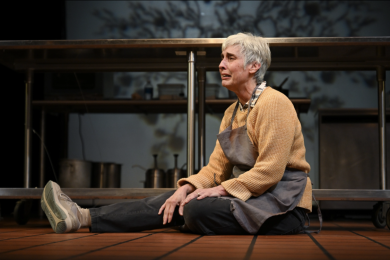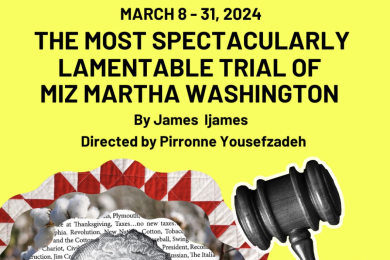How do you make a walk in the snow dramatic?

In Ezra Jack Keats’s beloved children’s book The Snowy Day, a boy walks around in the snow. That pretty much does it for plot, which isn’t to say The Snowy Day doesn’t deserve its classic status. It’s a visually striking book whose simple language and onomatopoeia have connected with several decades’ worth of young readers. Still, it’s not a work that obviously lends itself to the stage, what with its lack of narrative thrust and uniquely two-dimensional style.
That makes the new Children’s Theater mounting of four Keats classics all the more impressive. Playwright Jerome Hairston and directors Peter C. Brosius and Fabrizio Montecchi have managed to translate the soft-spoken, universal appeal of Keats’s books into an entertaining play that shows due respect to the source material without becoming dull or static. It’s also a confident exercise in genre-blending and one of the most visually distinctive productions of the season to date.
All four stories follow Peter, a young boy growing up in one of those throwback urban environments where unsupervised kids have neighborhood-wide snowball battles and dig around in the equally unattended local dump for entertainment. The other three segments are only slightly more narrative-driven than “The Snowy Day.” “Whistle for Willie” tracks his efforts to learn to whistle for his pet dachshund, “Goggles” finds Peter and a friend jockeying with two bullies for a junkyard treasure, and “A Letter to Amy” follows his attempt to invite a friend to his birthday party.
Ingenious visual effects
The simplicity of the stories places a sizable burden on the visual department, and fortunately this production is more than up to the task. Brosius and Montecchi recreate the unmistakable look of Keats’s cloth-and-paper collages via an ingenious mix of shadow puppetry, regular puppetry, brightly costumed actors and projected backdrops of Keatsian scenery. A given scene might find Montecchi’s puppets interacting in the stark black-and-white of shadow play, then shifting into the foreground as full-color characters, then disappearing completely as actor/puppeteers Mikell Sapp, Joy Dolo and Dean Holt embody Peter and his friends.
It’s an effect that could be jarring or disorienting in less assured hands, but here the transitions are so smooth and the tone so exuberant that there’s scarcely any disconnect between the different incarnations of the characters. In the context of the production it makes perfect sense for Peter to be a stiff-moving silhouette one second and a beaming, bouncing Mikell Sapp the next.
Of course, those transitions require the performers to go big, even by kids’ theater standards. Conveying the extreme ups and downs of childhood emotions via shadow puppetry is no easy task to begin with, and carrying that energy through to the non-puppet sequences without overwhelming the audience is even trickier. This cast pulls it off with aplomb, particularly Sapp, whose Peter is loud, exuberant and mercurial in a way that will ring a bell with anyone who’s spent significant time in the company of a young boy.
Abundant style and risky storytelling
Of course, the real mark of a successful children’s play is how it connects with children. The crowd I saw it with did get a tad restless as the show went on, but that may have been just a natural side effect of a preschool heavy audience viewing an hour-long play. The latter portion of the performance dips into some of the emotional complexity of late adolescence, as Peter battles bullies and frets over whether to invite a girl to his birthday. Perhaps not the edgiest material, but maybe a little heady for the crowd who’s in it for the “crunch crunch” sound effects.
The school-age kids in the audience, though, seemed very much invested in the show, despite much of the material holding equal appeal for younger kids.
A few months back on this website, I chided Children’s Theatre for an admittedly excellent Wizard of Oz that succeeded by looking and sounding exactly the way you’d expect it to. I took some (likely deserved) flak for that review, because hey, theater tickets aren’t cheap and when you have the means and the talent to put on a swell-looking Wizard of Oz that hits all the right notes, why would you do anything else?
But The Snowy Day hits at the kind of thing I was hoping to see more of: a familiar, beloved property reimagined in a way that’s faithful to its source but pushes the material into unexpected territory. There were any number of safe, straightforward roads Brosious and Montecchi could have taken to bring these classic books to the stage. Instead, they chose a path of abundant style, risky storytelling and, of course, shadow puppets. This is Ezra Jack Keats as you never would have guessed you wanted to see him.




